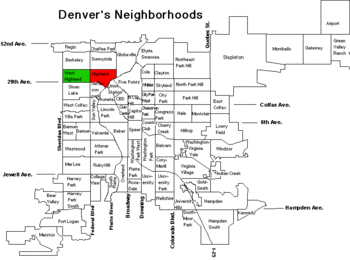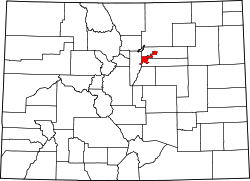Highland, Denver
Coordinates: 39°45′45.50″N 105°0′42.88″W / 39.7626389°N 105.0119111°W

Highland is a distinct city-center neighborhood in Denver, Colorado bounded by West 38th Avenue to the north, a Union Pacific Railroad line on the east, the South Platte River to the southeast, Speer Boulevard on the south, and Federal Boulevard on the west. The misnomer Highlands is sometimes used to refer to two separate city-center neighborhoods, Highland and West Highland, in Denver, Colorado, although the two neighborhoods are distinct. Highland and West Highland are both in the area that is referred to as North Denver.[1] is located immediately northwest of downtown. Note that the Highland neighborhood association has a slightly different definition with the easternmost boundary stopping at I-25.[2] And the West Highland neighborhood to the immediate west of Highland, with the borders of 38th and 29th Avenues on the north and south and Federal and Sheridan Boulevards on the east and west. To distinguish between its immediately adjacent neighbor, West Highland, Highland is sometimes referred to as East Highland, Lower Highland or LoHi. The two together are casually called "the Highlands," a term which often falsely encompasses other Northwest Denver neighborhoods such as Jefferson Park, Sunnyside and Berkeley. Realtors have particularly pushed the inclusion of the recently gentrified Berkeley, located directly north of West Highland, as part of the Highlands, sometimes going so far as to refer to Berkeley and parts of Sunnyside as the "Upper Highlands". To add further confusion, within the Highlands neighborhoods there are several historic designations of various degrees, including Potter Highlands, Scottish Highlands and Highlands Park.[3][4]
West Highland and the Highland neighborhoods (large portions of zip codes 80211 and 80212) currently has a population of about 57,000 people.[5][5]
Highland is often confused with the suburb of Highlands Ranch, located approximately 20 miles to the south. The similarity in name is merely a coincidence.
History
The townsite of Highland was laid out in December 1858 by William Larimer, Jr., who the previous month had founded Denver City.[6] In 1859 the Highland town company formed, and a Platte River bridge was planned to connect to Auraria and Denver.[7] The Rocky Mountain News noted:
- "No more handsome location for residences can be found than on the highlands of Highland, on the opposite side of the river from and overlooking Auraria and Denver, and a vast extent of surrounding territory."[8]
After the May 1864 flood wiped out parts of Denver, new people moved up the hill to the west. The Fifteenth Street Bridge made the western hills accessible and as the years passed streetcars made the area even easier to reach.
In 1875, Owen Le Fevre and other developers petitioned the Arapahoe County Commissioners to establish a village government. After annexing Potter Highland and Highland Park, they formed the Town of Highlands which became a city in 1885.
Residents were fairly homogeneous. Most were Protestant and they tended to vote Republican. Many men participated in the Masonic Lodge and other similar clubs. In 1892, the young men of Highland formed the North Denver Athletic Club which gave them facilities similar to those enjoyed at the Denver Athletic Club, playground of Denver's elite.
The women joined churches and other societies. One society of note was the North Side Women's Club, where they heard lectures and completed good works around the area.
The residents also counted on Owen Le Febre's artesian well for clean drinking water and the breezes from the west provided clean air by blowing away any smog. Residents supported bond issues for schools, a library, and other civic improvements because they expected to have those services. The founding fathers eventually found it difficult to maintain such city services. In 1896, after considerable discussion, the residents voted to allow Denver to annex the town.[9]
Separated from the city by the South Platte River and neighboring railyards, Highland remained suburban in character for some time while attracting a variety of immigrants. Large numbers of Italians migrated to the area. Scottish Highlands was a project of nineteenth century developers who wanted to "brand" a new neighborhood with a distinct identity. Hence the Scottish names and quaint curvy streets. The original name was Highland Park. (from Rebecca Hunt)
The arrival of the Denver Tramway Corporation streetcar line in Highland better connected the area to downtown Denver and led to growth. As a streetcar suburb, Highland developed commercial centers near streetcar stops, some of which still exist today, including 32nd Ave and Tejon, 32nd Ave and Zuni (then called Gallop), 32nd Ave and Federal (then called "The Boulevard" or "Boulevard F"), as well as 32nd and Lowell in the West Highland neighborhood, now renamed "Highland Square". The streetcar system was later dismantled in the 1950s.
Highland Today
The redevelopment of the Central Platte Valley in the late 1990s and early 2000s saw Highland's fortunes rise. Highland became much more accessible to downtown with the construction of the Denver Millennium Bridge and Platte River Bridge in the Central Platte valley, along with the construction of the Highland Bridge over Interstate 25 in 2006. Preservationists stepped in to save some of the city's most architecturally interesting areas within the Highland neighborhood, such as Potter-Highland Historic District and Stonemans' Row Historic District. Proximity to downtown led to rapid growth of the area in recent years, while the area today is one of the more sought-after city-center neighborhoods. Consequently, considerable redevelopment is occurring in Highland along with a noticeable rise in density, as high-end condominiums and lofts replace older structures and parking lots. However, Highland still offers a large stock of historic single family homes—now some of the closest historic single family construction to Denver's original town site on the South Platte River.
The racial breakdown for the West Highland neighborhood is 75.78% white, 19.17% Hispanic or Latino, 1.1% African American, 1.7% Asian, and 0.64% Native American.[10] The Highland neighborhood's racial makeup is 57.42% white, 37.25% Hispanic or Latino, 1.91% African American, 1.36% Asian, and 0.64% Native American.[11]
Crime in the Highland neighborhoods is on par with the Denver city crime rate, with a rate of 66 incidents per 1,000 people. Property crimes such as burglary, larceny theft, vehicle theft, and robbery are slightly above city and national averages, while violent crimes are slightly below.[11]
The North Denver Tribune, North Denver News, and the Highland United Neighbors, Inc. [H.U.N.I.] offer community papers that cover the Highland and other northwest Denver neighborhoods. There are two neighborhood associations that represent the two neighborhoods. West Highland Neighborhood Association [WHNA] and Highland United Neighbors, Inc. [H.U.N.I.] pronounced "Honey". Updated contact information for these neighborhood associations can be found at Denver's City Web site.
Gallery
-

Highlands from the Central Platte Valley
-

32nd Ave and Zuni, Lower Highland
-

Houses in Lower Highland
-

Commercial buildings along the old street car lines in Lower Highland
-

Restaurants in Highland Square, 32nd Ave and Lowell blvd
-

Typical side street, Denver Highland
-

Highland Park
-
The Old Highland Business District at 15th and Boulder streets
References
- ↑ http://www.denvergov.org/DenverMaps/downloads/maps/citywide/Neighborhoods.pdf
- ↑ http://www.denverhighland.org
- ↑ http://store.historicdenver.org/store/historic-denver-guides-series/potter-highlands-historic-district-denver/
- ↑ http://www.nationalregisterofhistoricplaces.com/co/Denver/districts.html
- 1 2 "80211". City-data.com. Retrieved 2008-12-07.
- ↑ David Kent Ballast, The Denver Chronicle, Houston, Tex.: Gulf Publishing, 1995, ISBN 0-88415-202-2, p.10.
- ↑ "From Pike's Peak," New York Times, 21 March 1860, p.2.
- ↑ "Highland," Rocky Mountain News, 10 September 1859, p.3.
- ↑ Dr. Rebecca Hunt Urban Pioneers:Continuity and Change in Two Denver, Colorado Neighborhoods, 1875-1998., UC Boulder, 1998.
- ↑ http://www.piton.org/index.cfm?fuseaction=CommunityFacts.Summary&Neighborhood_ID=934
- 1 2 http://www.piton.org/index.cfm?fuseaction=CommunityFacts.Summary&Neighborhood_ID=896
